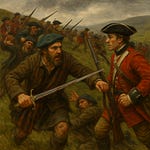Welcome back to "This Day in Scottish History." I'm your host, Colin MacDonald. Today, we journey back to a pivotal and violent moment in Scottish history, marked by betrayal, intrigue, and bloodshed. On September 3rd, 1571, a daring raid was launched on Stirling Castle, a stronghold of young King James VI's supporters. This raid, carried out by three hundred mounted troopers under the command of George Gordon, the 5th Earl of Huntly, targeted Regent Matthew Stewart, the 4th Earl of Lennox, and his allies. The violent event left an indelible mark on Scotland's turbulent history and set off a chain of reprisals that would ripple across the land.
At the heart of this tale is a one-year-old boy—James VI of Scotland. Born in June 1566 to Mary, Queen of Scots, and her second husband, Henry Stuart, Lord Darnley, James was thrust into a tumultuous world of political intrigue from birth. Crowned in July 1567 at the Church of the Holy Rude in Stirling, James became Scotland’s first Protestant king, a title he inherited under the shadow of a series of violent and uncertain power struggles. His mother, Mary, had been forced to abdicate the throne, and James's father had been murdered under mysterious circumstances. James was deprived of his parents' care and was raised within the formidable walls of Stirling Castle under the guardianship of Annabell Murray, Countess of Mar, and the guidance of George Buchanan, a staunch Protestant humanist scholar.
The raid on September 3rd, 1571, was a bold move by Huntly and his fellow Catholic rebels who supported Mary, Queen of Scots. Their objective was simple yet audacious: to capture Stirling Castle, seize the young king, and eliminate their enemies. The rebels managed to penetrate Stirling, and in the chaos that ensued, Regent Lennox was shot. This was a significant blow to the Protestant faction that supported young James. However, despite their efforts, the rebels failed to gain control of the castle or secure the young king. This incident did not just signify a loss for the rebel faction but also marked a turning point in the power struggle between the supporters of the deposed Mary and those loyal to her son, James VI.
In the aftermath of the raid, Scotland was further destabilized. The killing of Regent Lennox sent shockwaves through the noble families, sparking a series of confrontations. The Forbeses, staunch Protestants who were initially aligned with the Gordons, were horrified by the murder. This gruesome event fractured their alliance, turning former friends into bitter enemies. The resulting feud between the Forbeses and Gordons unfolded in a series of skirmishes throughout 1571, from Tilliangus to Corgarff Castle, fueling a cycle of vengeance that persisted for years.
One of the most enduring stories from this period involves a particularly gruesome myth that has captured imaginations for centuries. It tells of Henry "Harry" Gordon of Knock and his tragic fate at the hands of the Forbeses. According to the tale, Harry’s seven sons unwittingly began cutting peat on the land of Alexander Forbes of Strathgirnoc. Upon discovering this, Forbes allegedly beheaded the young men, placing their heads atop their peat cutters as a macabre warning. When Harry Gordon learned of his sons' fate, he supposedly fell to his death in shock. While this tale makes for a grim and gripping story, its authenticity is highly questionable. First appearing in the mid-19th century, it was later debunked by historians who found no evidence to support its claims.
Despite the lack of historical proof, these legends reflect the brutal realities of the time—a period marked by fierce clan rivalries, shifting alliances, and bloody retribution. The real Harry Gordon, as recorded in more accurate historical accounts, died in a skirmish in 1592 during a raid led by Angus Mac William of Clan Chattan, an act of retribution for the murder of James Stewart, the 2nd Earl of Moray. The Gordons and the Forbeses, like many Scottish clans of the era, were caught in the violent ebb and flow of political power struggles and personal vendettas.
In conclusion, the raid on Stirling Castle on September 3rd, 1571, stands as a stark reminder of Scotland's turbulent history during the regency of James VI. It was a time of uncertainty, betrayal, and conflict, where the lines between friend and foe were often blurred. As we reflect on these events, we are reminded of the fragility of power and the lengths to which individuals and clans would go to secure their place in history.
Thank you for joining us on this journey through Scotland’s dramatic past. Be sure to tune in tomorrow for another episode of "This Day in Scottish History." I'm Colin MacDonald, and as always, Haste Ye Back!













Share this post